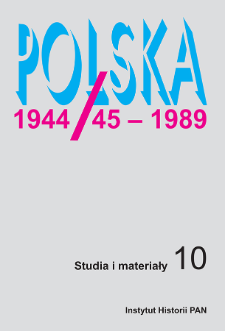- Wyszukaj w całym Repozytorium
- Piśmiennictwo i mapy
- Archeologia
- Baza Młynów
- Nauki przyrodnicze
Wyszukiwanie zaawansowane
Wyszukiwanie zaawansowane
Wyszukiwanie zaawansowane
Wyszukiwanie zaawansowane
Wyszukiwanie zaawansowane

Obiekt
Tytuł: Organizacja opieki nad dziećmi i młodzieżą w latach 1944–1950 – od prób realizacji przedwojennych rozwiązań do przejęcia wzorców radzieckich
Inny tytuł:
Polska 1944/45-1989 : studia i materiały 10 (2011)
Współtwórca:
Instytut Historii Polskiej Akademii Nauk
Wydawca:
Miejsce wydania:
Opis:
s. 135-154 ; Zawiera tabele. ; Streszcz. ang
Typ obiektu:
Abstrakt:
A reflection on the functioning of care for children and adolescents in Poland after World War II is far from full in Polish historiography.Although the postulate to centralise social care, coordinate it and increase the state’s participation in it, was put forward as early as 1944, in 1945–1947 political circumstances made it impossible for social care to be subject of endeavours of the communists.In these post-war years, the actual care for children and young people was totally dominated by social organisations. Children and adolescents were placed mainly in 380 children’s homes run by nuns, which made 43% of the total number of children’s homes residents in Poland. The “successes” of the Polish authorities in their first year of rule were limited to the takeover of a few charity organisations that were allowed to exist under the German occupation of Poland: the Central Welfare Council (Polish: Rada Główna Opiekuńcza) and Polish Red Cross (Polski Czerwony Krzyż).The later “competition” of the Polish Socialist Party (Polish acronym: PPS) and Polish People’s Party (PSL), together with what we usually call “civic society” influenced the “minimalism” of political ideas of the Polish Workers’ Party (Polska Partia Robotnicza) about this sphere of social reality, reflected mainly in pushing for the principle to build nurseries and kindergartens and in distribution of founds through the two PPR’s “own” ministries: the Ministry of Industry and Ministry of Supply. The Ministry of Industry, led by a PPR’s strong man, Hilary Minc, together with the Ministry of Supply and Trade, headed by an another PPR member, Jerzy Sztachelski, were the most important tools in the communist realisation of social care modelled on the Soviet examples.When finally the state control became possible (1949–1950), a majority of social organisations (including the charity ones) was suppressed or integrated. Such was the fate of children and adolescents organisations: the Polish YMCA , Central Committee of Social Care (Centralny Komitet Opieki Społecznej), Society of Orphans’ Nests and Kościuszko’s Villages (Towarzystwo Gniazd Sierocych i Wiosek Kościuszkowskich), “Caritas” and tens of smaller ones.
Czasopismo/Seria/cykl:
Polska 1944/45-1989 : studia i materiały
Tom:
Strona pocz.:
Strona końc.:
Szczegółowy typ zasobu:
Format:
Identyfikator zasobu:
oai:rcin.org.pl:59707 ; 2450-8357
Źródło:
IH PAN, sygn. B.155/10 Podr. ; IH PAN, sygn. B.156/10 ; kliknij tutaj, żeby przejść
Język:
Język streszczenia:
Prawa:
Licencja Creative Commons Uznanie autorstwa-Bez utworów zależnych 4.0
Zasady wykorzystania:
Zasób chroniony prawem autorskim. [CC BY-ND 4.0 Międzynarodowe] Korzystanie dozwolone zgodnie z licencją Creative Commons Uznanie autorstwa-Bez utworów zależnych 4.0, której pełne postanowienia dostępne są pod adresem: ; -
Digitalizacja:
Instytut Historii Polskiej Akademii Nauk
Lokalizacja oryginału:
Biblioteka Instytutu Historii PAN
Dostęp:
Kolekcje, do których przypisany jest obiekt:
- Repozytorium Cyfrowe Instytutów Naukowych > Kolekcje Partnerów > Instytut Historii PAN > Czasopisma
- Repozytorium Cyfrowe Instytutów Naukowych > Kolekcje Partnerów > Instytut Historii PAN > Wydawnictwa Instytutu
- Repozytorium Cyfrowe Instytutów Naukowych > Kolekcje Partnerów > Instytut Historii PAN > Wydawnictwa Instytutu > Czasopisma
- Repozytorium Cyfrowe Instytutów Naukowych > Kolekcje Partnerów > Instytut Historii PAN > Wydawnictwa Instytutu > Czasopisma > Polska 1944/45-1989
- Repozytorium Cyfrowe Instytutów Naukowych > Piśmiennictwo > Czasopisma/Artykuły
Data ostatniej modyfikacji:
16 gru 2020
Data dodania obiektu:
21 wrz 2016
Liczba pobrań / odtworzeń:
464
Wszystkie dostępne wersje tego obiektu:
https://rcin.org.pl/publication/78855
Wyświetl opis w formacie RDF:
Wyświetl opis w formacie RDFa:
Wyświetl opis w formacie OAI-PMH:
Obiekty Podobne
Juźwik, Aleksander
Juźwik, Aleksander
Juźwik, Aleksander
Juźwik, Aleksander
Smosarski, Ludomir
Drukier, Bolesław ( –2006)
Zwoliński, Stefan

 INSTYTUT ARCHEOLOGII I ETNOLOGII POLSKIEJ AKADEMII NAUK
INSTYTUT ARCHEOLOGII I ETNOLOGII POLSKIEJ AKADEMII NAUK
 INSTYTUT BADAŃ LITERACKICH POLSKIEJ AKADEMII NAUK
INSTYTUT BADAŃ LITERACKICH POLSKIEJ AKADEMII NAUK
 INSTYTUT BADAWCZY LEŚNICTWA
INSTYTUT BADAWCZY LEŚNICTWA
 INSTYTUT BIOLOGII DOŚWIADCZALNEJ IM. MARCELEGO NENCKIEGO POLSKIEJ AKADEMII NAUK
INSTYTUT BIOLOGII DOŚWIADCZALNEJ IM. MARCELEGO NENCKIEGO POLSKIEJ AKADEMII NAUK
 INSTYTUT BIOLOGII SSAKÓW POLSKIEJ AKADEMII NAUK
INSTYTUT BIOLOGII SSAKÓW POLSKIEJ AKADEMII NAUK
 INSTYTUT CHEMII FIZYCZNEJ PAN
INSTYTUT CHEMII FIZYCZNEJ PAN
 INSTYTUT CHEMII ORGANICZNEJ PAN
INSTYTUT CHEMII ORGANICZNEJ PAN
 INSTYTUT FILOZOFII I SOCJOLOGII PAN
INSTYTUT FILOZOFII I SOCJOLOGII PAN
 INSTYTUT GEOGRAFII I PRZESTRZENNEGO ZAGOSPODAROWANIA PAN
INSTYTUT GEOGRAFII I PRZESTRZENNEGO ZAGOSPODAROWANIA PAN
 INSTYTUT HISTORII im. TADEUSZA MANTEUFFLA POLSKIEJ AKADEMII NAUK
INSTYTUT HISTORII im. TADEUSZA MANTEUFFLA POLSKIEJ AKADEMII NAUK
 INSTYTUT JĘZYKA POLSKIEGO POLSKIEJ AKADEMII NAUK
INSTYTUT JĘZYKA POLSKIEGO POLSKIEJ AKADEMII NAUK
 INSTYTUT MATEMATYCZNY PAN
INSTYTUT MATEMATYCZNY PAN
 INSTYTUT MEDYCYNY DOŚWIADCZALNEJ I KLINICZNEJ IM.MIROSŁAWA MOSSAKOWSKIEGO POLSKIEJ AKADEMII NAUK
INSTYTUT MEDYCYNY DOŚWIADCZALNEJ I KLINICZNEJ IM.MIROSŁAWA MOSSAKOWSKIEGO POLSKIEJ AKADEMII NAUK
 INSTYTUT PODSTAWOWYCH PROBLEMÓW TECHNIKI PAN
INSTYTUT PODSTAWOWYCH PROBLEMÓW TECHNIKI PAN
 INSTYTUT SLAWISTYKI PAN
INSTYTUT SLAWISTYKI PAN
 SIEĆ BADAWCZA ŁUKASIEWICZ - INSTYTUT TECHNOLOGII MATERIAŁÓW ELEKTRONICZNYCH
SIEĆ BADAWCZA ŁUKASIEWICZ - INSTYTUT TECHNOLOGII MATERIAŁÓW ELEKTRONICZNYCH
 MUZEUM I INSTYTUT ZOOLOGII POLSKIEJ AKADEMII NAUK
MUZEUM I INSTYTUT ZOOLOGII POLSKIEJ AKADEMII NAUK
 INSTYTUT BADAŃ SYSTEMOWYCH PAN
INSTYTUT BADAŃ SYSTEMOWYCH PAN
 INSTYTUT BOTANIKI IM. WŁADYSŁAWA SZAFERA POLSKIEJ AKADEMII NAUK
INSTYTUT BOTANIKI IM. WŁADYSŁAWA SZAFERA POLSKIEJ AKADEMII NAUK




































